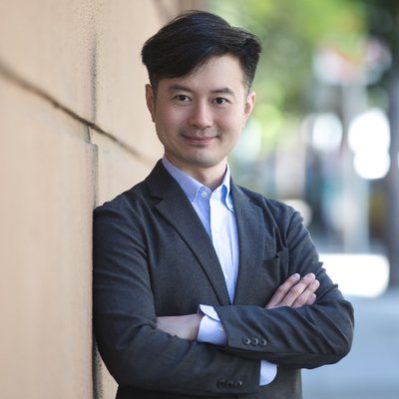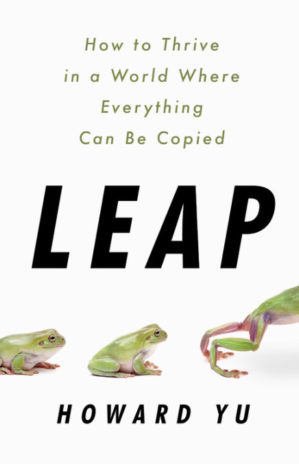As companies strive for the next big innovation, there are other who are only a step behind, copying their competitors’ every move. In this episode of Mastering Innovation on Sirius XM Channel 132, Business Radio Powered by The Wharton School, Howard Yu, Lego Professor of Management and Innovation at IMD Business School and author of Leap, discussed what distinguishes the companies that manage to resist disruption and displacement by newcomers.
Inspired by countless complaints of executives and managers about the commoditization of their products, Yu set out to discover what makes a company successful in the long-term. Citing the history of the textile, pharmaceutical, auto industries, Yu narrows down what it takes to thrive in an ever-changing global economy. He emphasizes the importance of true innovation in leadership, even if it means cannibalizing your existing sales. Together, Yu and Chaudhuri discuss the past and present examples of thriving companies and what it takes to truly “leap” from one discipline to another.
An excerpt of the interview is transcribed below. Listen to more episodes here.
Transcript

Saikat Chaudhuri: I want to jump right in. You’ve written this book, Leap, which was just recently released; it sounds like such an intriguing title as well. Tell us about some of the key findings that you have in that book.
Howard Yu: Sure. The reason really begins when I interacted with my executive and manager. They always complained that their product is getting commoditized, they find it harder and harder to differentiate in the marketplace, introduce new features, and come up with a new offering. There’s new innovation, overnight; it’s almost getting copied.
This complaint really got me to try to study and understand, taking a long-term perspective, how do companies actually thrive in an age when everything can be copied? It could be Asian competition, or the way smart machines are copying human intuition in the form of algorithms. It’s both looking in the past, as well as projecting some of the lessons learned going forward as well.
Chaudhuri: Fascinating. I’m intrigued by some of the examples you have in your book, including the historical one. Let’s start there. Southern textile mills, you draw that as an example. Tell us a little bit more about their situation and how they navigated it.
Yu: Sure. The textile industry, in many ways, is the example of brutal globalization or global competition. It started off from the U.K., obviously, and then fairly rapidly moved to the northeast, New England, then what you mentioned before, the south.
At the turn of the century, the southerners built bigger and larger textile mills. They were busy exporting to an international growing market. This is back in the turn of the century, and a growing market they were focusing on, ironically, was China. The Chinese back then were craving the cheap cloth manufactured in the United States, and they couldn’t buy enough.

It’s because of the rise of the international demand, we see the expansion of the southern mill. They pretty much displaced everyone from the U.K. to the northeast and became the global contender.
Of course, they were very successful until the arrival of the dollar blouse from Japan after World War II. Suddenly, the southerners were getting trapped by low-cost competition, first from Japan, and then from Taiwan, then from Hong Kong, where I grew up. Later on, of course, it all migrated to mainland China. Today it’s India, Bangladesh, and increasingly, even the African continent.
In the textile industry, what we saw is this example of a race to the bottom, and no one wins. Knowledge and machines and jobs, they all migrate from one country to the next. This set up pretty much the context as we examine a similar dynamic. Not just textiles, but if you’re looking at personal computers, automotive, wind turbines, solar panels — industry after industry, this latecomer would almost always catch up to the pioneering company and displace their market position.
As a result, the country or the industry cluster would collapse. This is something that contemporary policymakers to politicians to industry titans are very worried about. That set up the historical tone for me to investigate further.
Chaudhuri: What really resonates with me, the new point you’re making there, is we’ve seen this pattern over and over again where firms like Kodak or Nokia, Blackberry, and others, they struggle and they get displaced. There are some firms like Apple and IBM and others who are able to reinvent themselves and really adapt over time.
“In the textile industry, what we saw is this example of a race to the bottom, and no one wins.” – Howard Yu
The point that really strikes me is that it has implications for entire clusters, geographies, as well as countries and economies. And that’s where the policymaker angle comes in, too.
Yu: Quite right. What spurred me to go on further is I wanted to find out: Are there exceptional industries where somehow the poor company can continue to prosper over a century, and as a result, the industry cluster continues to thrive and the cities continue to prosper?
Where I live in the east part of Switzerland, there’s the city called Basel. In Basel, there are many pharmaceutical companies, led by Novartis, Roche, and many others as well. It turns out, Novartis’ predecessors, Ciba-Geigy and Sandoz, and including Roche, they have settled down along with the town of Basel for 250 years.
Here is an industry that has settled down in the same city for more than two centuries, never being displaced by a latecomer, and continuing to lead drug discovery and treatment so much so that the cluster continues to prosper and the city inhabitants continue to enjoy one of the highest living standard in Western Europe. I got intrigued, and I wanted to understand why and how.
Chaudhuri: So, tell us why. What’s the secret to those companies being able to do it?
Yu: Turns out, back in the old days, 250 years ago, Ciba-Geigy and Sandoz, they were a chemical firm. They were making chemical dyes for the textile industry. Now, somehow, some of these chemists discovered, “Oh, there are medicinal benefits for the chemical dye.” They introduced the world’s first blockbuster in the 1920s called antipyretic, fever-reducing drugs.
If you think for a moment, the drug discovery, the hotbed for innovation back then was all about organic chemistry. You might remember back in high school, we learned about Alexander Fleming, antibiotics. After the Second World War, all the pharmaceutical companies across the world, including Pfizer in the United States, they all focused around a study of microbiology to find out the next most potent fungus, the cream that kills off bacteria.
“The pioneering company will have a much higher headroom for growth if they are willing to take that leap forward.” – Howard Yu
This is in search for the pay dirt. Suddenly, everything around pharmaceutical discovery is based on the new knowledge discipline called the study of microbiology. There is a leap in terms of foundational knowledge, from organic chemistry to microbiology.
Today, if you ask any scientist what’s hot in the discovery of drugs, of course, it’s genomic, informatics, DNA screening, and so on. Moving away from microbiology to the whole rubric of science called genomics, pharmaceutical companies are facing three different types of radical leap, versus organic chemistry leaping to microbiology and finally genomics.
Compare and contrast that to the automotive industry. Until most recently, before [electric vehicles] or sharing economy or autonomous driving, it has always been mechanical engineering on the internal combustion engine. The knowledge basically has stayed stagnant. Same thing with the wind turbine, same thing with the personal computer. It’s little wonder why the latecomer can actually catch up.
If the underlying knowledge discipline continues to leap from one to another, then the pioneering company will actually have much higher headroom for growth if they are willing to take that leap forward.
About Our Guest
Howard Yu is the author of LEAP: How to Thrive in a World Where Everything Can Be Copied, LEGO professor of management and innovation at the prestigious IMD Business School in Switzerland, and director of IMD’s signature Advanced Management Program (AMP), a three-week executive course. He delivers customized training programs for major global companies, including ASML, Mars, Maersk, Electrolux, Daimler, Sanofi, Novartis and others. A native of Hong Kong with a doctoral degree from Harvard Business School, he writes regularly for Forbes, Fortune, Harvard Business Review, Sloan Management Review, and the South China Morning Post.
His teaching and research collaboration with organizations in Asia includes China’s TravelSky, China Resources, COFCO, and Tencent; Japan’s Nitto and Recruit Holdings; Singapore’s Temasek. His work in Europe includes ASML, Daimler, Bosch, Electrolux, LEGO, Sanofi, and Novartis. Professor Yu received his doctoral degree in management from Harvard Business School. Prior to his doctorate, he worked in the banking industry in Hong Kong.
Mastering Innovation is live on Thursdays at 4:00 p.m. ET. Listen to more episodes here.



